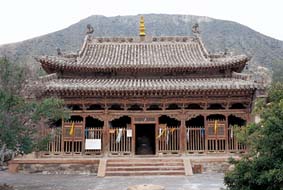
Qutan Temple, located in a mountain valley near the capital city of Qinghai Province, was first constructed in the early Ming Dynasty. This grand Chinese-style Tibetan Lama temple was built against the background that the Ming Dynasty supported Tibetan Lamaism to better rule the Tibetan area. As Qutan is the surname of Sakyamuni, the founding emperor of the Ming so named the temple as Qutan to show respect for Buddha. The original temple was expanded during the reign of following emperors.
Qutan Temple stands on an open, quiet spot, with Luohan Hill behind and Phoenix Hill and Qutan River in front of it. It used to be surrounded by city walls but only debris is left now. The temple occupies a floor space of 10,000 square meters. The whole building complex consists of three courtyards. Along the axis line there are the Front Gate, Guardian Warriors Hall, Qutan Hall, Devine Light Hall and Longguo Hall respectively. On each side of the axis line buildings are located symmetrically Imperial Stone Tablet Pavilion, Mural Corridor, Small Bell and Drum Tower, Big Bell and Drum Tower, Buddha Pagoda, Small Buddha Hall and Sutra Hall. The temple's layout and building styles resemble the Forbidden City so much that it is called a miniature Forbidden City.
Huge painted murals on the Mural Corridor are the most valuable artwork of the temple. The murals, occupying a total of some 400 square meters, describe Sakyamuni's whole life, from his birth till his death. The murals were made with mineral pigments and remain colorful and splendid after five hundred years. The murals depicts various subjects, including stars, cloud, rain, the sun, the moon, mountains, rivers, trees, flowers, human figures, animals, palaces, pavilions and etc..
Qutan Temple, designated as a key heritage site under the state protection, features a typical Chinese style. Its well-preserved buildings have provided valuable references for the study of ancient arts and architecture.
